Jan
29th
Stay connected Subscribe to our RSS feed
Renault Sport F1 is the division established by Renault to represent its interests in the FIA Formula One World Championship and is tasked with designing and building optimised engines that can be fully integrated into a chassis package by RSF1's carefully selected partner teams.
The current power plant, codenamed the RS27, is a 750bhp V8 engine with a capacity for 18,000rpm.
In 2013 identical units are supplied to four partner teams: Red Bull Racing, Lotus, Williams and Caterham.
SPECIFICATIONS RS27 ENGINE*
DESIGNATION: RS27-2012
CONFIGURATION: 2.4L V8
NO OF CYLINDERS: 8
NO OF VALVES: 32
DISPLACEMENT: 2400cc
WEIGHT: 95kg
V ANGLE: 90°
RPM: 18
FUEL: Total
OIL: Total
POWER OUTPUT: >750 bhp
SPARK PLUGS: Semi surface discharge
IGNITION SYSTEM: High energy inductive
PISTONS: Aluminium alloy
ENGINE BLOCK: Aluminium alloy
CRANKSHAFT: Nitrided alloy steel with tungsten alloy
counterweights
CONNECTING RODS: Titanium alloy
THROTTLE SYSTEM: 8 butterflies
ENGINE STATISTICS*
2,500
2,500 parts make up one RS27 engine.
95 kg
The vital statistics of the engine are partly determined by the regulations. For example, the engine's weight and centre of gravity must meet a minimum criterion. As a result the engine weighs 95kg, the equivalent to two small grown women, but this could be even less if given free rein !
Materials
Each engine piece is carefully crafted to be as light as possible whilst optimising the weight
distribution. Materials such as aluminium and titanium are used for their lightweight properties.
900° C
During a race, the exhausts of the RS27 will reach up to 900°C, an average consumer oven will only reach 240°C. These temperatures are very close to the melting point of most metals, therefore, special lightweight materials are used to make the exhausts.
750 bhp
Each engine is capable of producing approximately 750bhp. Most road car engines produce between 120 and 180bhp, less than 25% of the RS27.
2 tons
The actual weight of a piston is only 250g but when the engine revs to its maximum limit of 18,000rpm this weight exerts a force of 2 tonnes on its connecting parts.
2.5 s
The RS27 can accelerate from
0 to 60kph in 1.6 seconds. It can do 0 to 100 km/h (62 mph) in 2.5 seconds, 0 to 200 km/h (124 mph) in 5.1 seconds and 0 to 300 km/h (186 mph) in 12.0 seconds dependant on aerodynamic setup and gearing.
220 litres
Over the course of an average race, the RS27 will consume approximately 220 litres of fuel.
3,000 km
Each race is a maximum of 300km, but each F1 engine is capable of running to around 3,000km, ten times a race distance. It's not a lot compared to an average road car user, who will run 16,000km per year, but the average road car engine does not rev to 18,000rpm!
20,000 hours
Renault Sport F1 has 10 test beds at its factory. Each dyno at Viry will run for 4.5 days a week, 12 hours a day. Even taking into account holidays and downtime that's equivalent to more than 20,000 hours dyno time per year!
* From Renault Sport F1
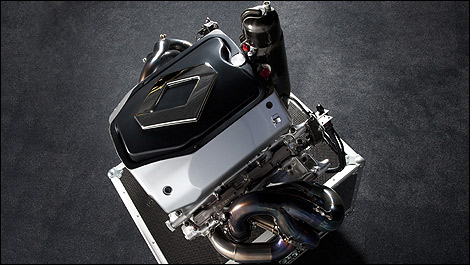 |
| Photo: Renault |
The current power plant, codenamed the RS27, is a 750bhp V8 engine with a capacity for 18,000rpm.
In 2013 identical units are supplied to four partner teams: Red Bull Racing, Lotus, Williams and Caterham.
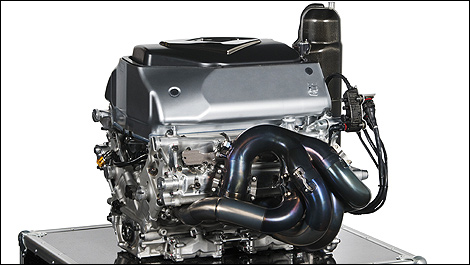 |
| Photo: Renault |
SPECIFICATIONS RS27 ENGINE*
DESIGNATION: RS27-2012
CONFIGURATION: 2.4L V8
NO OF CYLINDERS: 8
NO OF VALVES: 32
DISPLACEMENT: 2400cc
WEIGHT: 95kg
V ANGLE: 90°
RPM: 18
FUEL: Total
OIL: Total
POWER OUTPUT: >750 bhp
SPARK PLUGS: Semi surface discharge
IGNITION SYSTEM: High energy inductive
PISTONS: Aluminium alloy
ENGINE BLOCK: Aluminium alloy
CRANKSHAFT: Nitrided alloy steel with tungsten alloy
counterweights
CONNECTING RODS: Titanium alloy
THROTTLE SYSTEM: 8 butterflies
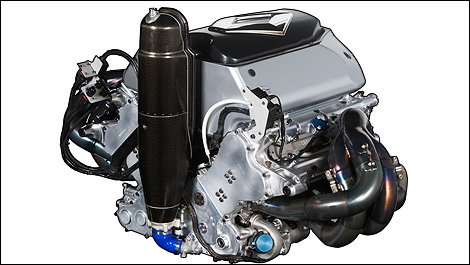 |
| Photo: Renault |
ENGINE STATISTICS*
2,500
2,500 parts make up one RS27 engine.
95 kg
The vital statistics of the engine are partly determined by the regulations. For example, the engine's weight and centre of gravity must meet a minimum criterion. As a result the engine weighs 95kg, the equivalent to two small grown women, but this could be even less if given free rein !
Materials
Each engine piece is carefully crafted to be as light as possible whilst optimising the weight
distribution. Materials such as aluminium and titanium are used for their lightweight properties.
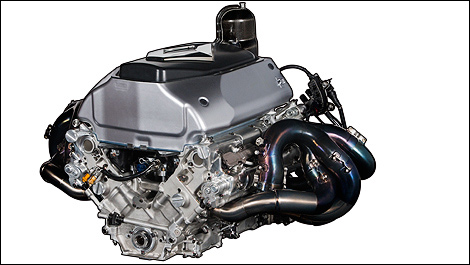 |
| Photo: Renault |
900° C
During a race, the exhausts of the RS27 will reach up to 900°C, an average consumer oven will only reach 240°C. These temperatures are very close to the melting point of most metals, therefore, special lightweight materials are used to make the exhausts.
750 bhp
Each engine is capable of producing approximately 750bhp. Most road car engines produce between 120 and 180bhp, less than 25% of the RS27.
2 tons
The actual weight of a piston is only 250g but when the engine revs to its maximum limit of 18,000rpm this weight exerts a force of 2 tonnes on its connecting parts.
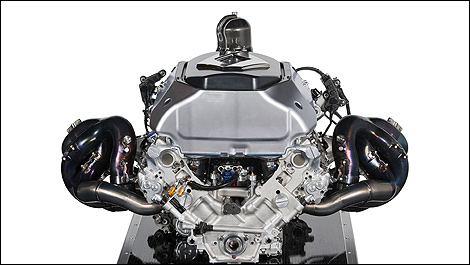 |
| Photo: Renault |
2.5 s
The RS27 can accelerate from
0 to 60kph in 1.6 seconds. It can do 0 to 100 km/h (62 mph) in 2.5 seconds, 0 to 200 km/h (124 mph) in 5.1 seconds and 0 to 300 km/h (186 mph) in 12.0 seconds dependant on aerodynamic setup and gearing.
220 litres
Over the course of an average race, the RS27 will consume approximately 220 litres of fuel.
3,000 km
Each race is a maximum of 300km, but each F1 engine is capable of running to around 3,000km, ten times a race distance. It's not a lot compared to an average road car user, who will run 16,000km per year, but the average road car engine does not rev to 18,000rpm!
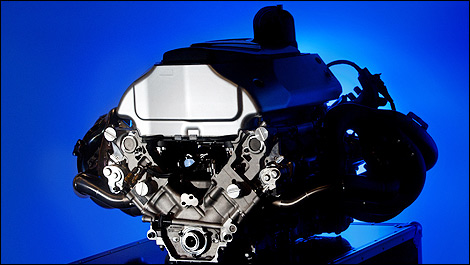 |
| Photo: Renault |
20,000 hours
Renault Sport F1 has 10 test beds at its factory. Each dyno at Viry will run for 4.5 days a week, 12 hours a day. Even taking into account holidays and downtime that's equivalent to more than 20,000 hours dyno time per year!
* From Renault Sport F1
 The latest auto news, reviews, prices, product and vehicle releases.
The latest auto news, reviews, prices, product and vehicle releases.